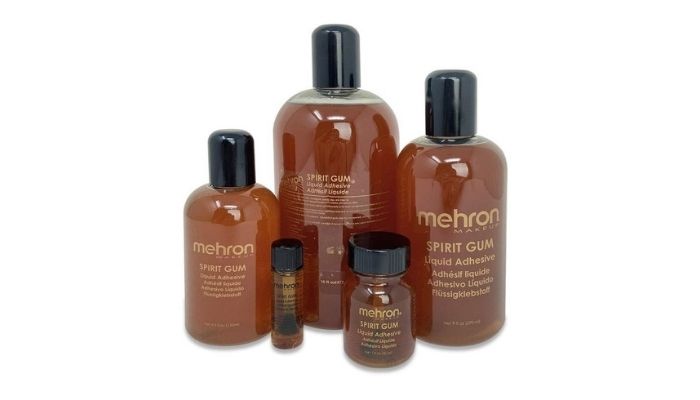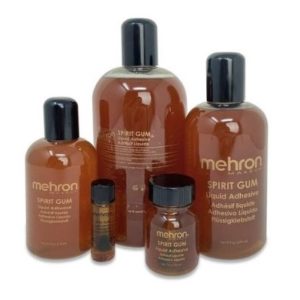Part of every FX artist’s tool kit is spirit gum – almost every FX artist utilizes spirit gum, applying it to several special FX designs. An FX artist needs to be experienced in its usage to know what type is applied to the corresponding application. In this article, we’ll be discussing the types of spirit gum, and what it is. We’ll also list how you can remove it.

First Things First, What is Spirit Gum?
For a beginner, the term “spirit gum” can raise a lot of questions; it’s not that complicated when you learn how to use it, but if someone just started, they’re more likely not to know about this gum. But that’s what this article is for! In simple words, an adhesive made from a mixture of solvent and resin is called spirit gum.
The “spirit” part comes from the solvent, and the “gum” part comes from the resin; functioning as the glue. Many (almost every) FX artist use this tool, making it a major part of the special FX industry because of its effectiveness. Depending on the person, it may cause some irritation, but it’s perfectly safe to apply in most cases.
It’s been used in the FX industry since the 1870s, with little to no change in the formula. This gum now only differs in terms of refinement; so the only thing that changed in more than 150 years is the spirit gum’s refinement.
What is it used for?
This gum can be applied to almost everything in the special FX industry. It’s used for applications of facial prosthetics from noses and ears to hairpieces such as eyebrows, mustaches, beards, and even wigs. Different types of functions are different, so an FX artist needs to be aware of what type works best for what.
In general, the gum works best for lightweight applications like facial hair; there are options available for heavier applications.
Different Types of Spirit Gum
As we’ve mentioned above, there are different types; each works best for its corresponding application.
- Matte Spirit Gum
- TV Spirit Gum
- Hydro Spirit Gum
How to Apply Prosthetics with this
Applying prosthetics isn’t as difficult as it seems; it’s as simple as the steps mentioned below:
- Apply this gum on your skin (where you want it), and let it dry a little until it is tacky to the touch and not wet.
- Now apply the prosthetic to the adhesive while keeping yourself firm, and hold it in place for about 30 seconds to ensure it has properly adhered.
How to Remove it When Using Prosthetics
Follow the steps listed below to remove this gum when using prosthetics:
- Following the recommendation, it’s best to use a spirit gum remover; ripping it off can cause pain and irritation to the skin.
- Use a cotton swab or cotton ball; soak the remover and use it to remove the prosthetic appliance, gently applying the remover under the piece.
- Doing that will loosen the gum and eventually, it’ll detach.
- After that, use the remover of the remaining gum from the area of the skin it was applied to.
- The final step is to wash the skin with warm water and apply soap as well. Use a moisturizer if you feel the need to; avoid using any alcohol-based products in this case.
With that said, these are all the steps you need to follow to remove the gum when using prosthetics. As mentioned above, do not attempt to use rip it off; use a remover; otherwise the procedure can be painful.
How to Remove it with Hairpieces
To remove this gum with hairpieces; follow the steps listed below:
- In the case of traditional solvent-based spirit gum; use a spirit gum remover, and apply it to a cotton ball.
- Next, work the remover under the hair appliance in a gentle manner so the adhesive can break down while being removed (gently).
- If you’re using water-based spirit gum, all you have to do is remove it using warm, soapy water.
- The final step is to wash your face thoroughly to remove any remaining gum, and if need be, use a moisturizer.
(As mentioned above, avoid using any alcohol-based products)
This concludes the article; we’ve mentioned what spirit gum is, its types and how to remove it. We hope you find this article useful; if you have any further questions/queries, feel free to comment down below. We’ll respond to you in due time.
READ MORE: Best Time to Take Collagen

